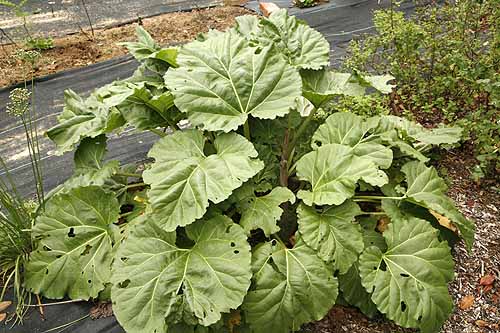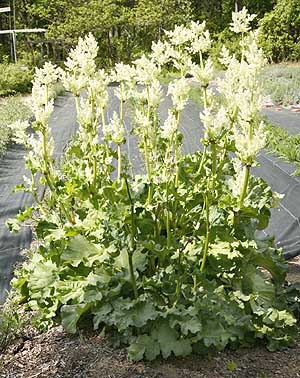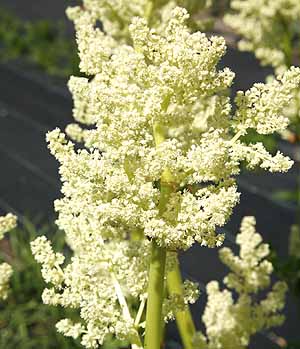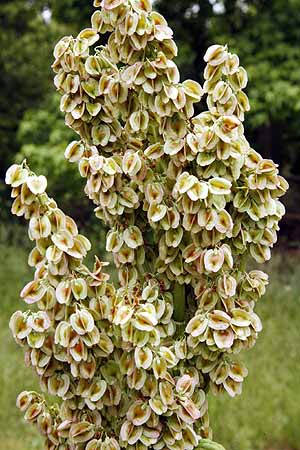Garden or English Rhubarb is a delightful plant with large attractive leaves. It's a hardy perennial and does not really need a lot of attention once planted. For those who want it for its delicious stalks some attention to feeding is desireable but it also makes a very dramatic herbacious plant with tall eye catching flower stalks that draw attention from a long distance. Best grown in zones 4-7b as does not do as well in hot areas. Likes full sun but may need some dappled shade in hotter areas. Easy to grow from seed and can harvest in second year. Will need some water if grown as vegetable. Mostly wild life ignore it but deer may eat it if desparate. They ate our bed down to the ground one year.
Description of English Rhubarb (Rheum rhaponticum).
Large perennial plant that is hardy to zone 3. In spring leaves erupt from the
ground and unfold into very large heart shaped leaves with deep white veins
that cause leaf to crinkle and pucker. Minor veins are more subtle Underside
of leaf shows veins as much more pronounced as they stand out slightly from
the leaf body. Edges are crinkly and scalloped shaped and leaves can reach 3
feet in length and almost as wide. Stems are thick strongly ribbed and juicy.
The color can range from green through pinks to bright red sometimes yellow.
Often several colors appear on the same stem. Can reach three feet in height.
Leaves are produced in a wide arching grouping that will increase in size each
year from thick tuberous roots. In late spring thick hollow stiff stems rise
and begin to branch once they clear the cover of the ground leaves. All branches
produce small clumps of miniature leaves at intervals along with a flower stalk.
Flower stalks are also much branched with each branch holding hundreds of very
tiny white tubular flowers. Flowers can last for 2-4 weeks and are loved by
butterflies and beneficial insects. Flowers are followed by three lobed seeds
that are first green and red then dry to brown.
HOW TO GROW English Rhubarb (Rheum rhaponticum).
Location and Care
This hardy perennial is going to be in the same place for many years so preparing
the soil before you plant is highly recommended. Most gardeners grow rhubarb
as a vegetable for its delicious stalks to increase the number of these rhubarb
needs a little care. It's a cool season plant and does best above zones 7b-
8a, its usually far to hot any further south.
Rhubarb needs cold to trigger spring growth and it tolerates cold extremely
well being hardy to around minus -20°F ( minus -29°C).
Rhubarb likes full sun on a moist soil, but not waterlogged. It loves heavy
soils that retain moisture. If however your soil is sandy or sandy loam which
drains very well it might be better to select a sight that has a small amount
of shade during the noon hours or the plant can dry out and wilt badly. Sight
shade is preferable to adding a lot more water since this is more time consuming.
Select your site carefully and allow plenty of space as plants can get very
large. Plant at least 3 feet apart four if your soil is very good or it has
been very well amended.
Dig into the soil as much compost or well rotten organic material as you can.
Rhubarb is a very heavy feeder and will suck up everything that you give it.
We recommend digging at least two feet down and about three to four feet wide
around each intending planting. Mix in compost or soil amendment, we do not
recommend peat moss as it is not a renewable resource.
Watering
Keep new transplants well watered at all times. Since rhubarb has such large
leaves and juicy stalks it takes up a lot of water. Using a soaker hose curled
around each plant or snaked between plants to allow for as much watering as
possible is ideal. Water as
needed. If soil is clay and retains water well less
will be needed than for well drained sandy soils.
The best way to water rhubarb is from the ground not from overhead. Soaker hoses
ensure that the water reaches the roots of the plant, overhead the water is
often deflected by the leaves and ends up on a nearby plant instead. Also overhead
watering can increase the humidity of the leaves and encourage diseases like
downy mildew and encourage slugs.
Once established plants should be fed and mulched. Adding a top dressing of compost or organic mulch every year is ideal and dressing of fertilizer every year to help keep leaves coming. Use a fertilizer high in nitrogen to encourage leaf grown and reduce likelihood of flowering.
Most sources recommend that flowers be removed to encourage the plant to produce more leaves. This is a good idea but we have found it depends on your location. For cooler zones 3-5 this seems to work well. However from zone 6 and more it just encourages the plant to produce a new flower stalk. We have found that cutting off flower stalks just forces the plant to expend more energy making a new one and not producing more leaves. This seems to deplete the plant more and we still don't get a good prolonged leaf harvest. Our best results have been using a high nitrogen to encourage leaves and leave the flowers alone. That way we only get a few flower spikes which we enjoy as a flowering plant and ensure we get our stalks harvested before the flowers arrive. We encourage growers to experiment and see what is the best for their particular setting.
Its not just a vegetable is also a beautiful flowering plant
While most gardeners grown this plant for its leaves it does also make a wonderful
flowering plant. The massive tall flower stalks are very dramatic in the garden
and last for several weeks. If flowering is desired use a fertilizer with less
nitrogen to encourage flowers. Location is still key with some shade dappled
shade required in hotter areas to keep down water demands. Rhubarb still needs
watering or it can be planted in a slightly moist areas as a flowering plant
and will do extremely well. If planted in most soil shade may not be necessary.
Rhubarb for enjoyment needs very little care of maintenance. Some leaves can
be removed before the plant flowers so both the beauty of the edible stalks
and the flowers can be enjoyed.
In all cases remove dead leaves in late fall or early spring to clear the way for the next seasons growth. Adding compost or mulch at this time gives the plant a good feeding for the beginning of the year.
Growing Rhubarb in a Pot
Rhubarb also makes a interesting pot plant that can be placed on a deck or patio
for a large lush leaves and also delicious stalks. Needs a large container as
they have big root systems so need at least 1.4 cubic feet (40 liters) of compost
to get a decent size plant and any crop. Use a good humus mixed with compost
and soil and feed and water well. Potted plants will need more water than in
ground plants. Use high nitrogen fertilizer.
Stem Color of Rhubarb
Stem color can vary from plant to plant and is more red in some varieties than
others. However temperature also plays a large part in stem color. The reddest
colors are produced during cold weather with optimum temperatures around 50°F
(10 °C), above 77°F (25°C) growth slows and stems tend to stay green.
Growing English Rhubarb (Rheum rhaponticum) from Seed.
Indoors. Start seed about 6-8 weeks before last frost date. Either sow
1-2 seeds to a small pot or use individual cell pot trays. Some sources recommend
soaking the seeds for 24 hours before sowing. In some cases this can speed up
germinations but its not necessary. Cover
seeds lightly, do not plant too deeply.
Keep seeds moist but not wet until the germinate which can be as little as 6-18
days at about 70°F (21°C). Grow plants on until at least 3" tall
then harden off outside in shady area gradually moving to full sun until ready
to transplant. Ensure bed is well prepared as described above.
Outdoors. Can be sown directly. Ensure that bed has been well prepared
as described above plant seeds in groups of about 4 and then thin out as seedlings
grow. Can be transplanted at this stage if desired.
Harvesting English Rhubarb (Rheum rhaponticum).
Stalks: Harvest stalks by pulling them off DO NOT CUT. Cutting can introduce
diseases into the plant and destroy your crop. Pull each rhubarb stalk from
the base of the stem and twist them away from the crown.. Only remove a few
stems from each plant at one picking, we recommend about 1/3 of the leaves at
each picking to ensure that plants remain strong and healthy. In most cases
several picking can be done during one season. Plants much retain sufficient
leaves to allow them to build up food reserves in their roots to grown next
year. Do not harvest any leaves during the first year of growth, allow the plant
time to establish itself.
Stems are harvested in early spring and summer. Pick younger leaves when
they have just fully unfurled. Stop harvesting in early summer and allow the
plant to grow naturally. Some sources recommend that flowers be removed to encourage
leaves we suggest that high nitrogen fertilizer works better and leave the flowers
alone.
Roots: Use only those that are at least four years old, six can be preferable.
They are harvested in October, washed and dried for later use.
Storing.
Fresh rhubarb stalks can be stored 2-3 weeks at 33°F in the refrigerator.
To prepare for freezing, clean the stalks and cut them into one inch (2.5 cm)
pieces and then water blanch for one minute. Cool, drain well, and place into
freezer bags or containers, making sure to leave some headroom at the top of
each.
Pests and Diseases of English Rhubarb (Rheum rhaponticum).
There are not too many diseases that affect rhubarb, sometimes slugs will attack
and very occasionally in very humid conditions it may be affected by downy mildew.
To ensure plants stay healthy water from the ground using soaker hoses or such
like. Do not water leaves as this may encourage mildew and slugs.
In warm regions or locations with too much water crown rot can be a problem.
Ensure that soil is fairly well draining and humidity is not to high.
Wildlife usually don't eat rhubarb but if they are hungry deer will eat the
leaves. We have a lot of deer around us and occasionally they will eat all the
leaves down but its not a common occurrence.
Medical uses of English Rhubarb (Rheum rhaponticum).
The roots of rhubarb have long been used to help the digestive system. Garden
rhubarb is considered to be a milder laxative and more astringent, for many
this makes it a better choice than the Chinese (turkey) variety. Its major purpose
is as a laxative but in smaller does it acts as a tonic to the whole digestive
system. It is used as a detoxifying agent to cleans the liver and gall bladder
and to treat constipation, diarrhea, hemorrhoids, menstrual problems and skin
eruptions. A homeopathic root preparation is used to treat stomach problems
and diarrhea in children especially those who are teething. Externally it is
used to treat burns and as a wash for scrofulous sores.
A decoction of the seeds is supposed not only to ease pains in the stomach,
but to strengthen it by increasing the appetite.
Edible Uses of English Rhubarb (Rheum rhaponticum).
Leaf stem is the most
common portion used. IN most cases it is cooked as the
stems contain oxalic acid making them sharp and astringent. Rhubarb stems make
wonderful desserts, jellies, jams, tarts and combined with other fruits especially
strawberries. The young flower pouch, apparently can be harvested before the
flowers open, and is said to form a dish of great delicacy
Caution. As rhubarb contains oxalic acid
it is not recommended for consumption by people suffering from gout, kidney
stones, arthritis and rheumatism.
Leaves should not be eaten. There are many claims that the leaves are poisonous
although the reason for this and just how much varies with every source. Some
claim that the level of oxalic acid in the leaves is much higher, others say
it's the same as the stalks but that the leaves contain a variety of glycosides
which cause the toxic properties. Whatever the reason the leaves should be avoided.









